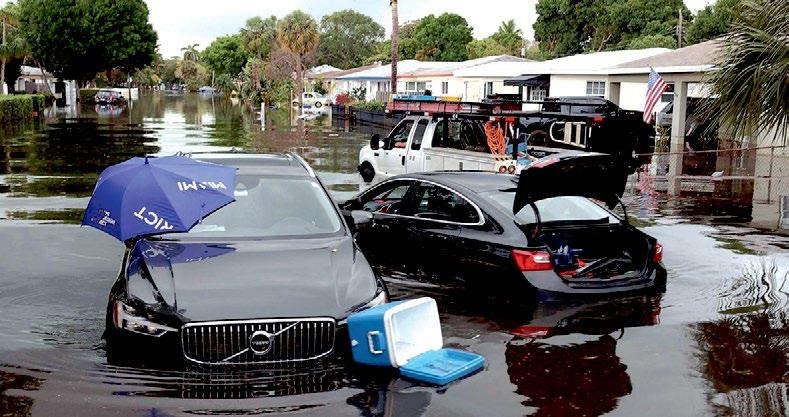
3 minute read
Sign Of The Times?
BY HOWARD CAMPBELL
Rain of Biblical proportions brought Fort Lauderdale to a soggy standstill on April 13th. Meteorologists estimated that 26 inches of rainfall hit parts of South Florida that day, forcing the Fort Lauderdale-Hollywood International Airport, schools and some businesses to close.
Advertisement

Dean Trantalis, mayor of Fort Lauderdale, described the historic showers as “unprecedented.” On April 22, Florida Governor Ron DeSantis said he would seek a major disaster declaration for Broward County to secure federal aid for flood victims.
The dramatic drenching took place two months before the Hurricane Season and again sparked debate about climate change and the dangers of a world getting warmer. For Audrey Wright Peterman, a Jamaican environmentalist who lived in South Florida for many years, the damage done to South Florida was on the cards.
“I had a sinking feeling as I watched the storms and the deluge. I wrote about the possibility of this happening back in 2016, because as an environmentalist watching the rapid increase in development that is pouring concrete over the land we need for absorption and drainage,” she said in an interview with Caribbean Today.
“Additional concrete also increases heat, and the process of evaporation, condensation and precipitation is increasingly disturbed. The water has nowhere to go because of the foolishness of man trying to make a buck off every inch of space. And as a result, everyone is put in jeopardy,” Peterman added.
She noted that South Florida and the Caribbean are “in the bullseye for climate change effects” and believes because administrators focus on another major project in the region, they have neglected putting safety measures against unstable weather, in place.
“In 2017, after attending the conference of the Everglades Coalition of more than 40 of the top environmental groups and finding them still focused on acquiring land to restore the Everglades (which I totally support, by the way) I became very concerned that they were not sufficiently focused on sealevel rise. I wrote the article, ‘Body Bags cloud my vision at Everglades Conference,’ and was roundly chastised by one leader,” said Peterman, who addresses the dangers of climate change in her 2019 book, ‘From my Jamaican Gully to The World And Back!’ “But that actually happened with Hurricane Ian when people were washed out to sea screaming in their homes.”
Peterman returned to Jamaica permanently four years ago, and continues to educate people there about the dynamics of changing weather patterns. Tropical storms in recent years have caused devastating land slippages in rural Jamaica, leaving many people homeless and making roads impassable.
In 2020, according to the United Nations Environment Programme, Jamaica, “became the first Caribbean country to submit a tougher climate action plan to the UN because the country was at risk from rising sea levels, drought and more intense hurricanes.”
Last September, in a speech to the United Nations, Jamaica’s prime minister Andrew Holness said Small Island Development States are in danger of being wiped out if they do not receive assistance to prevent climate shocks.
“Concerted action to slow down and halt global temperature rise is literally a question of our survival. While we will continue to develop our own resilience and play our part in mitigating climate change, we cannot, by our action alone, change the trajectory,” Holness stated.
Similar steps are being taken in Trinidad and Tobago which experts say is warming 2.5 faster than the global average. Dire projections for the twin-island Republic and its CARICOM partners, were presented at Climate Analytics Caribbean, held April in Port of Spain.
Kishan Kumarsingh, head of the Multilateral Environmental Agreements at T&T’s Ministry of Planning and Development, recently pointed to the importance of Caribbean states living up to Nationally Determined Contributions which present plans for climate change as outlined in the 2015 Paris Agreement.
He stressed that the T&T government has taken crucial steps to prevent runaway warming, such as:
• Procurement of 240 electric buses to further reduce emissions from the CNG initiative.
• Development of a green hydrogen roadmap, with assessment on the feasibility of wind power both onshore and offshore to power the green hydrogen economy, and.
• Development of a net zero plan consistent with the Paris Agreement to identify additional emissions reductions opportunities and actions to raise mitigation ambition.
As for Fort Lauderdale and South Florida, the historic April 13th rainfall may be an ominous sign of things to come.
“We’re going to see this kind of intensification in years to come because of climate change,” said Broward County commissioner, Beam Furr. “We may be calling it a 1-in-1,000year event. I think that number is going to be dropping.”










